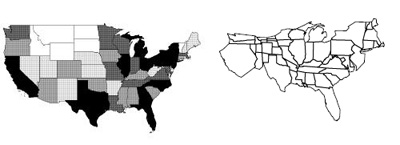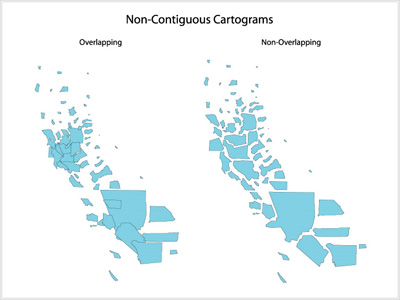Teaching:TUW - UE InfoVis WS 2008/09 - Gruppe 01 - Aufgabe 1 - Cartogram
Cartogram
Definition
A Cartogram is a small diagram, on the face of a map, showing quantitative information or an abstracted and simplified map the base of which is not true to scale. Simply we can say cartograms are unique representations of geographical space. They use cartographic outlines to represent data which depends on this source [Bortis and Demers, 2002].

On the left side you can see a traditional map of the United states and on the right side a Cartogram of USA depending on the population density.
Types of Cartograms
- Non-Continuous Cartograms
In non-continuous cartograms the regions on the map don't have to be connected to their neighbors. In this type of cartogram it is important to see the shape of the original map. User will recognize the map just because of their borders. The regions in the map are displaying the content with their own size. For an example a region with a smaller population will be smaller than a sector with a higher population [Kocmoud, 1997].

- Continuos Cartograms
Different to the non-continuous cartograms, the important point is that the regions in the map are connected to each other. Accordingly the shape of each region is changing their size [Bortis and Demers, 2002]. Therefore the outline of the hole map changes. As we can see in the picture below, France is very distorted but still connected to his neighbors. With changing the shape of this country, the outlines of the whole map has changed [Wikipedia, 2008].

- Perimeter-Preserving Cartograms
In this version the outline of the map is the same as in the original image. The regions in it are still connected to each other, so the only change is the border of the regions which is moving but still connected to his neighbors [Kocmoud, 1997].
- The usage of different shapes for representation of the regions
One type that can be used is the Dorling Cartogram. In this form the original regions are replaced with circles of varying size. With this kind of shape it is easier to see the difference between the regions. The same strategy is used by Demers which is use squares instead of circles. The positive effect of this is, that there are no free spaces between them [Florisson et al., 2005].
References
- [Bortis and Demers, 2002]Ian Bortis, and Steve Demers, USGS, Cartogram Central. Created at: December 7, 2002. http://www.ncgia.ucsb.edu/projects/Cartogram_Central/index.html .
- [Kocmoud, 1997] Christopher James Kocmoud, Constructing Continuous Cartograms:
A Constraint-Based Approach. Created at: December, 1997. http://www-viz.tamu.edu/faculty/house/cartograms/Thesis.html .
- [Florisson et al., 2005] Sander Florisson, Marc van Kreveld, and Bettina Speckmann. Rectangular Cartograms : Construction & Animation. 'Annual Symposium on Computational Geometry'.372–373, 2005.
- [Wikipedia, 2008] Wikipedia. Cartogramm. Retrieved at: October 5, 2008. http://en.wikipedia.org/wiki/Cartogram .